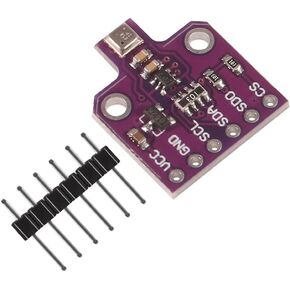- Shopping, made easy.
- /
- Get the app!
Specifications:
Size: 0.83 inches* 2.01 inches
Weight: 0.71 Oz
ROM: 384KB
FLASH: 4MB
WIFI: IEE 802.11bgn
Bluetooth: BLE 5.0 & mesh
Chip: ESP32-WROOM-32
Connection: USB Type C
Antenna: PCB On-board
About Interface:
This development board has one SPI flash with 4MB storage capacity, which can be expanded up to 16MB.
It features 2 UART interfaces, UART0 and UART1, with UART0 serving as the download port.
There is a 5-channel 12-bit ADC on this board, with a maximum sampling rate of 100KSPS.
A low-speed SPI interface is also included in master mode.
There is an IIC controller on this board.
It has 4 PWM interfaces that can use any GPIO.
There are 15 external GPIO pins that can be multiplexed.
Additionally, it includes two SMD LED indicators, a reset button, a BOOT button, and a USB to TTL download debug port.
Notes:
To avoid the ESP32 from entering download mode, the BOOT (IO09) pin should not be pulled down before powering up.
It is not recommended to externally pull down the IO08 pin when designing, as this may prevent downloading via serial port when the pin is low during the download and burning process.
In QIO mode, IO12 (GPIO12) and IO13 (GPIO13) are multiplexed for SPI signals SPIHD and SPIWP, but for increased GPIO availability, the development board uses 2-wire SPI in DIO mode, and as such, IO12 and IO13 are not connected to flash. When using self-compiled software, flash must be configured to DIO mode accordingly.
Since the VDD of the external SPI flash is already connected to the 3.3V power supply system, there is no requirement for additional power supply configuration, and it can be accessed using the standard 2-wire SPI communication mode.
By default, GPIO11 serves as the VDD pin of the SPI flash, and thus requires configuration before it can be utilized as a GPIO.
 ACEIRMC BME680 Digital Temperature Humidity Pressure Sensor Breakout Board Compatible for Arduino Raspberry Pi ESP8266 3~5VDC BME680 (2pcs)
KWD 11.500
ACEIRMC BME680 Digital Temperature Humidity Pressure Sensor Breakout Board Compatible for Arduino Raspberry Pi ESP8266 3~5VDC BME680 (2pcs)
KWD 11.500
 ACEIRMC 8pcs ESP8266 ESP-12E Serial Wireless Module CH340 NodeMcu V3 Lua WiFi Internet of Things New Version Development Board Compatible with Arduino IDE/MicroPython (8pcs)
KWD 5
ACEIRMC 8pcs ESP8266 ESP-12E Serial Wireless Module CH340 NodeMcu V3 Lua WiFi Internet of Things New Version Development Board Compatible with Arduino IDE/MicroPython (8pcs)
KWD 5
 10pcs PCF8575 IO Expander Board Module I2C to 16IO IIC I2C I/O Extension Shield Module 16 bit SMBus I/O Ports for Arduino R3 (10pcs)
KWD 7
10pcs PCF8575 IO Expander Board Module I2C to 16IO IIC I2C I/O Extension Shield Module 16 bit SMBus I/O Ports for Arduino R3 (10pcs)
KWD 7
 ACEIRMC ESP8266 NodeMCU LUA CP2102 ESP-12E Internet WiFi Development Board Open Source Serial Wireless Module Internet for Arduino IDE Micropython (6pcs)
KWD 7
ACEIRMC ESP8266 NodeMCU LUA CP2102 ESP-12E Internet WiFi Development Board Open Source Serial Wireless Module Internet for Arduino IDE Micropython (6pcs)
KWD 7